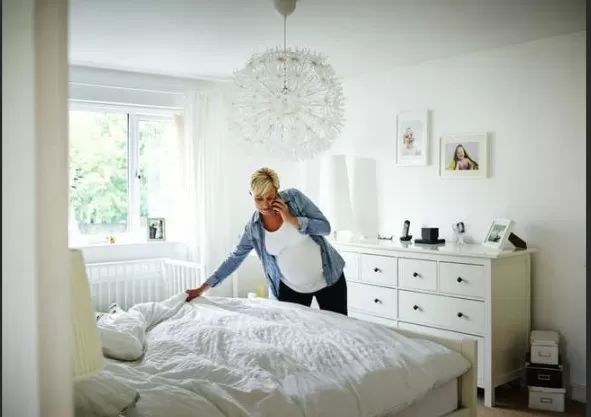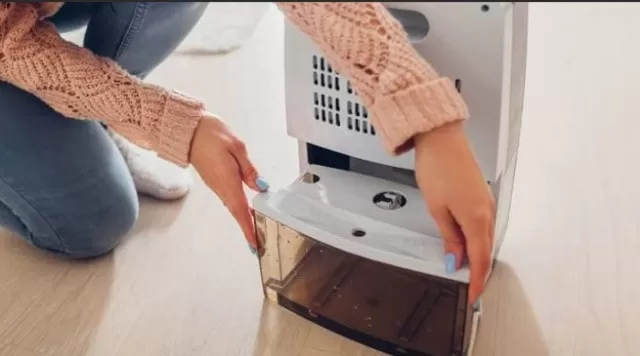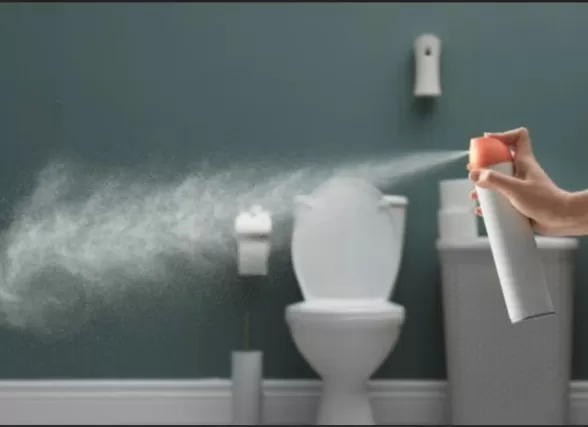Unveiling Indoor Air: Reasons It’s Not as Pure as You Think. As warmer temperatures beckon us to open our windows and enjoy fresh air, it is important to recognize that the need for ventilation extends beyond simply enjoying good weather.
Even the cleanest homes can harbor indoor air that is filled with contaminants, which can have negative effects on our health. Everyday sources such as cooking smoke, moisture, and cleaning products can contribute to impure indoor air, leading to allergies and illnesses. By letting the outside breeze flow in, we can help mitigate the presence of these pollutants and prevent them from recirculating within our living spaces. Read on to explore the reasons why indoor air may not be as pure as we assume and discover effective ways to improve its quality.
The Unseen Hazards: Unveiling the Airborne Pollution Caused by Cleaning Products

When it comes to maintaining cleanliness, one would expect that using cleaning products is the best solution.
However, a hidden danger lies within those seemingly innocuous sprays and cleansers. Unbeknownst to many, these conventional cleaning products often contain unregulated chemicals that have the potential to contaminate the air we breathe.
Volatile organic compounds, commonly known as VOCs, are among the culprits responsible for releasing toxic fumes into our living spaces.
The impact of these airborne pollutants should not be taken lightly.
Exposure to such hazardous chemicals can lead to various health issues, ranging from bothersome headaches to debilitating nausea and other ailments. It becomes increasingly concerning when one considers the fact that many people unknowingly subject themselves to these health risks by cleaning their homes with closed windows, thereby trapping the toxic fumes indoors.
To safeguard our well-being, a shift towards using all-natural or do-it-yourself (DIY) cleansers becomes imperative.
By opting for these alternatives, we not only minimize our exposure to harmful chemicals but also contribute to a healthier living environment. Embracing all-natural or DIY cleaning solutions is a proactive step that ensures the air we breathe remains free from the pollutants concealed within traditional cleaning products.
It’s time to recognize the unseen hazards lurking in our cleaning routines and take action to protect ourselves and our loved ones.
By making conscious choices and embracing cleaner options, we can create a safer and healthier atmosphere within our homes while preserving the Air Quality for a better future.
The Hidden Perils of Artificial Fragrance: Unveiling the Dangers of Air Fresheners
Creating a pleasant and inviting atmosphere in our homes is a common desire, often achieved through the use of air fresheners and scented candles.
However, the price we unknowingly pay for these olfactory pleasures can be steep. It turns out that many commercially available air fresheners and scented candles harbor a dark secret—they contain harmful carcinogens that can jeopardize our health.
While we may be tempted to prioritize a clean and fresh-smelling home at any cost, it’s crucial to consider the potential risks associated with artificial fragrance.
These products often emit toxic substances that pose a threat to our well-being. The presence of carcinogens within the very scents we use to enhance our surroundings can have far-reaching consequences for our health.
To maintain a naturally fresh-smelling home without compromising our well-being, a shift toward homemade potpourri or natural, unscented candles is highly recommended.
By opting for these alternatives, we can enjoy delightful scents without exposing ourselves to harmful chemicals. However, if parting with artificial fragrance is a challenge, there are still measures we can take to mitigate the risks.
Whenever lighting a scented candle, it is crucial to crack open a window, allowing fumes to escape while inviting fresh air into our living spaces.
By acknowledging the hidden dangers of artificial fragrance and embracing safer alternatives, we can safeguard our health and well-being.
Let us strive for a home that not only smells inviting but also prioritizes the purity of the air we breathe. Through informed choices and mindful actions, we can create a harmonious environment that nurtures both our senses and our overall wellness.
The Link Between Humidity and Airborne Contaminants: Unveiling the Hazards of Moist Environments

It may come as a surprise, but high humidity levels can contribute significantly to indoor air pollution.
When our living spaces become excessively damp, it creates the perfect breeding ground for a host of contaminants, including dust mites, mold, and mildew. These unwelcome guests thrive in moist conditions, multiplying and spreading throughout our homes, posing potential health risks.
In addition to the proliferation of unwanted organisms, excess moisture also triggers another concerning issue.
Hardwood floorboards, commonly found in many households, can release formaldehyde—a colorless gas—into the air. When present in elevated concentrations, formaldehyde can cause irritation to the eyes, nose, and throat, leading to discomfort and potential health concerns.
To combat the negative effects of high humidity and minimize the spread of airborne contaminants, it is essential to take proactive measures.
Running a dehumidifier proves to be an effective solution, as it helps remove excess moisture from the air, creating an environment less favorable for the growth of dust mites, mold, and mildew. By maintaining optimal humidity levels, we not only protect our health but also create a more comfortable and healthier living space.
Awareness of the connection between humidity and indoor air pollution empowers us to make informed decisions regarding our home environments.
By prioritizing humidity control and taking advantage of tools such as dehumidifiers, we can effectively reduce the risks associated with airborne contaminants, promoting a healthier and more enjoyable indoor atmosphere for ourselves and our loved ones.
Unlocking Complete Air Purification: Understanding the Need for Multiple Filters
When it comes to achieving pristine indoor air quality, a single air purifier may not suffice.
It’s important to recognize that household air pollutants can be categorized into two main types: harmful particulate matter and gaseous matter. To effectively combat these different impurities, it becomes necessary to employ a combination of filters designed to target each type specifically.
Particulate matter encompasses various airborne particles such as smoke, pollen, dust, and even tobacco smoke.
To effectively capture and eliminate these particulates, a High-Efficiency Particulate Air (HEPA) filter proves to be highly effective. With its fine mesh of fibers, a HEPA filter can efficiently trap even the tiniest particles, ensuring cleaner and healthier air for your living space.
However, it’s important to note that gaseous pollutants, such as paint fumes and vapors from cleaning products, require a different approach.
These volatile compounds cannot be effectively captured by a HEPA filter alone. That’s where a carbon filter comes into play.
A carbon filter is specifically designed to adsorb and trap gaseous pollutants, effectively reducing their presence in the air you breathe.
To achieve comprehensive air purification and address both particulate matter and gaseous pollutants, it is crucial to install both a HEPA filter and a carbon filter in your air purifier.
This dual filtration system provides a well-rounded defense against a wide range of indoor pollutants, ensuring that your indoor air quality remains clean and fresh.
By understanding the unique characteristics of different pollutants and employing the appropriate filters, we can unlock the full potential of air purifiers and create an environment where both particulate matter and gaseous impurities are effectively eliminated.
Let us prioritize complete air purification and breathe easier in spaces that are truly free from harmful contaminants.
The Paradox of Energy-Efficient Homes: Balancing Conservation and Indoor Air Quality

Energy-efficient homes are undoubtedly beneficial for conserving heat or cool air, resulting in reduced bills throughout the year.
However, it’s essential to recognize that tightly sealed homes, while promoting energy conservation, can inadvertently lead to a stuffy indoor environment. The lack of airflow in these well-insulated homes can contribute to a persistent issue—contaminants, including volatile organic compounds (VOCs), continue to circulate within the indoor air, potentially causing allergies and discomfort.
The tight seal that keeps conditioned air inside the home also traps pollutants, allergens, and odors, preventing them from escaping and allowing them to accumulate.
VOCs, often present in cleaning products, paints, and household items, can contribute to poor indoor air quality when confined within a sealed environment. Prolonged exposure to these airborne contaminants can result in various health issues and discomfort for occupants.
To strike a balance between energy conservation and indoor air quality, it is crucial to promote adequate airflow within the home.
One simple yet effective solution is to crack open windows whenever feasible. By allowing fresh outdoor air to enter the living space, stale air can be exchanged, reducing the concentration of indoor pollutants and improving overall air quality.
Recognizing the importance of maintaining healthy indoor air, it becomes clear that compromising airtightness in favor of sufficient ventilation is necessary.
Striking a balance between energy efficiency and indoor comfort requires conscious efforts to introduce fresh air into the living environment. By embracing the practice of periodically opening windows, we can create a healthier and more enjoyable home atmosphere, free from the stagnant circulation of contaminants that may compromise our well-being.
*The information is for reference only.